 Animals
Animals  Animals
Animals  Weird Stuff
Weird Stuff 10 Weird Things People Used to Do at New Year’s
 Our World
Our World 10 Archaeological Discoveries of 2025 That Refined History
 Weird Stuff
Weird Stuff 10 Fascinating Facts You Might Not Know About Snow
 Miscellaneous
Miscellaneous Top 10 Things Crypto Was Supposed to Change & What Actually Did
 History
History 10 Huge Historical Events That Happened on Christmas Eve
 Music
Music 10 Surprising Origin Stories of Your Favorite Holiday Songs
 History
History 10 Less Than Jolly Events That Occurred on December 25
 Weird Stuff
Weird Stuff 10 Funny Ways That Researchers Overthink Christmas
 Politics
Politics 10 Political Scandals That Sent Crowds Into the Streets
 Animals
Animals 10 Species That Refused to Go Extinct
 Weird Stuff
Weird Stuff 10 Weird Things People Used to Do at New Year’s
 Our World
Our World 10 Archaeological Discoveries of 2025 That Refined History
Who's Behind Listverse?

Jamie Frater
Head Editor
Jamie founded Listverse due to an insatiable desire to share fascinating, obscure, and bizarre facts. He has been a guest speaker on numerous national radio and television stations and is a five time published author.
More About Us Weird Stuff
Weird Stuff 10 Fascinating Facts You Might Not Know About Snow
 Miscellaneous
Miscellaneous Top 10 Things Crypto Was Supposed to Change & What Actually Did
 History
History 10 Huge Historical Events That Happened on Christmas Eve
 Music
Music 10 Surprising Origin Stories of Your Favorite Holiday Songs
 History
History 10 Less Than Jolly Events That Occurred on December 25
 Weird Stuff
Weird Stuff 10 Funny Ways That Researchers Overthink Christmas
 Politics
Politics 10 Political Scandals That Sent Crowds Into the Streets
Top 10 Facts About Earth and its Orbit
The Earth passes through four seasons as it orbits the Sun, along with increasing daylight length in the six months between the winter and summer solstice and decreasing daylight length between the summer solstice and the winter solstice. We also experience a 24-hour cycle that is the Earth’s daily rotation, and a 28-day cycle that is the Moon’s rotation around the Earth. These are cycles that repeat indefinitely. However, many subtleties are hidden in and around these cycles, that most people do not know about, cannot explain, or do not notice.
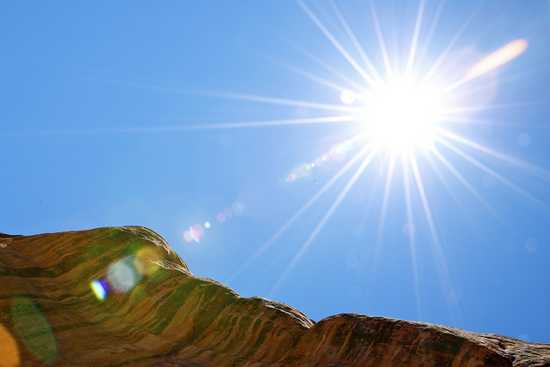
Fact: The Sun is not necessarily the highest at noon.
The change in the time the sun is at its highest point in the sky (true noon) varies throughout the year. This happens for two reasons: the Earth’s orbit is an ellipse, rather than a circle, and the Earth is tilted with respect to the Sun. Since the Earth is rotating at a (very nearly) constant speed but is orbiting faster at some times of year than others, sometimes the Earth’s rotation is either ahead of, or is lagging behind its respective orbital in a circular orbit. The change due to Earth’s obliquity can best be thought of by imagining points close to each other all around the Earth’s equator. If you tilt the circle of points by 23.44 degrees (the current value of Earth’s obliquity), you see that all except the points now on the equator and tropics change their longitude. There is also a change in the time the point the Sun is highest in the sky with the observer’s geographical longitude (that is which longitude they reside in their local time zone) but that factor is constant for each longitude.
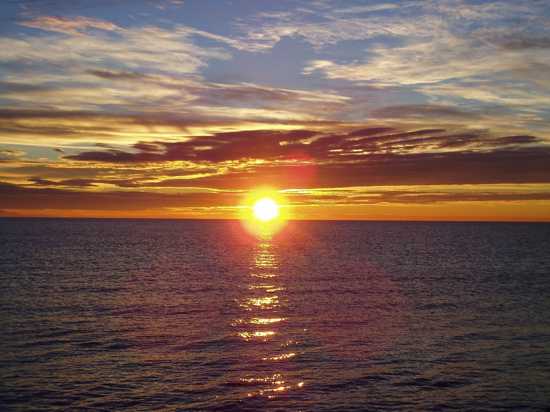
Fact: Sunrise/sunset times do not change direction immediately at the solstices.
Most people think that, in the northern hemisphere, the sun sets the earliest on the December solstice and sets the latest on the June solstice. This is not actually true. The solstices are simply the dates in which, the daylight length is the longest or the shortest. However, the change in the time of true noon pulls the sunrise and sunset times with it. At the December solstice, true noon is getting later at a rate of 30 seconds per day. Since there is no change in daylight length right on the solstices, sunset is also getting later at a rate of 30 seconds per day and so is sunrise. Since sunset is getting later at the winter solstice, the earliest sunset has already happened. Since sunrise is also getting later at this date, the latest sunrise still has yet to come. It also happens that the latest sunset takes place a short time after the summer solstice and the earliest sunrise takes place a short time before the summer solstice. However, this difference is not as significant as that of the December solstice, because the change of noon due to eccentricity at this solstice is detracting from the change of true noon due to obliquity, (change of true noon due to obliquity is positive at both solstices), but the total rate of change is still positive.
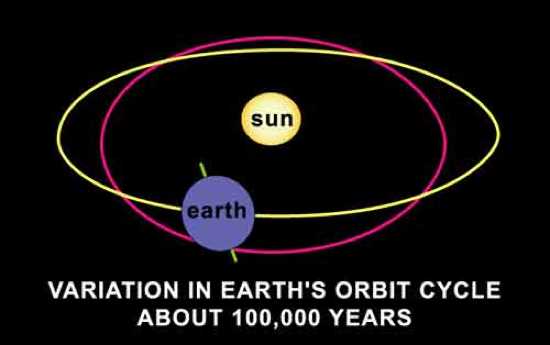
Most people know that the Earth orbits the Sun in an ellipse, rather than a circle, but the value of the Earth’s orbital eccentricity is approximately equal to 1/60. A planet that orbits its sun periodically always has an eccentricity between 0 and 1, including 0 but excluding 1. An eccentricity of 0 means the orbit is a perfect circle with the Sun at the center and the planet orbiting at a constant speed. However, such an orbit is extremely unlikely as there is a continuum of possible eccentricity values. The eccentricity, in a closed orbit, is measured by dividing the distance between the Sun and center of the ellipse by the length of the semi-major axis of the ellipse. The orbit becomes increasingly longer and thinner the closer the eccentricity gets to 1. The planet always orbits fastest when it’s nearest to its Sun and slowest when it’s farthest from its Sun. When the eccentricity is greater than or equal to 1, the planet comes around its Sun once and flies back out into space never to be seen again.

The Earth goes through periodic wobbles, known and nutation. This is due mainly to outside gravitational forces pulling on the Earth’s equatorial bulge. The Sun and Moon pull on Earth’s bulge, making the Earth wobble. However, for casual astronomical observations, these effects are negligible. The Earth’s obliquity and longitude have a period of 18.6 years, the time it takes for the Moon to circle through its nodes, and lesser wobbles of six months and two weeks, which are due to the orbit of the Earth around the Sun and the Moon’s orbit around the Earth, respectively.

Fact (kinda): Earth really is flat.
I suppose the Catholics from Galileo’s era were maybe just a tiny bit right in believing the Earth to be flat. It just so happens that the Earth is almost spherical but it is slightly flattened at the poles. The Earth’s equatorial radius is 6378.14 kilometers, but its polar radius is 6356.75 kilometers. Consequently, geologists have had to come up with different versions of latitude. Geocentric latitude measures the viewers latitude as an angle with respect to the equator and the center of the Earth. Geographic latitude measures the viewer’s latitude as an angle with respect to the equator and a straight line extending directly below his feet. Geographic latitude is the standard for plotting maps and identifying coordinates. However, the angle measuring the Earth-Sun declination (how far north or south the Sun shines on the Earth depending on the time of year) is always measured as a geocentric value.
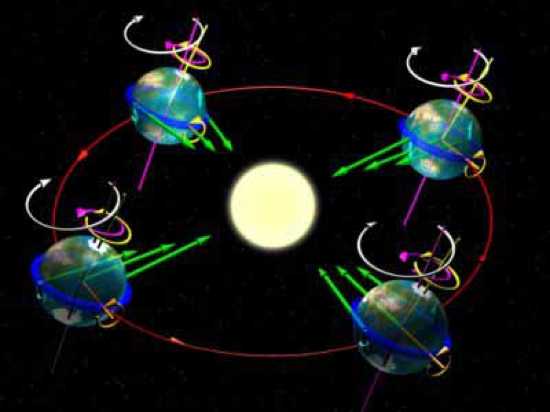
The Earth’s axis slowly spins like that of a top. Also, the ellipse forming the Earth’s orbit very gradually rotates, making the shape traced out by the earth around the Sun over many years form a daisy. Due to both types of precession, astronomers have identified three types of years: sidereal year, (365.256 days) which is one orbit with respect to distant stars, anomalistic year (365.259 days), which is the length of time it takes for the Earth to travel from its closest point (perihelion) to its farthest point from the Sun (aphelion) and back again, and tropical year (365.242 days) the duration from one spring equinox to the next.
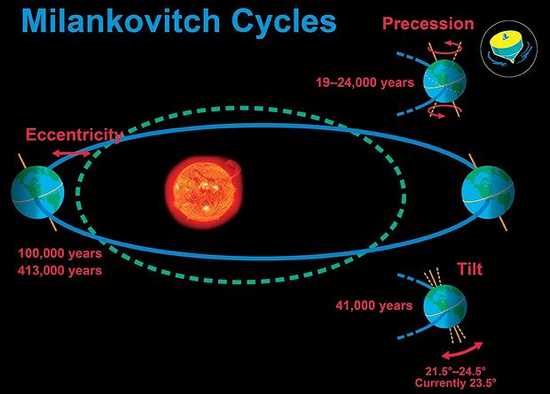
Astronomer, Milutin Milankovitch, discovered, in the early 20th century, that the Earth’s obliquity, eccentricity and precession are not constant. Over a period of about 41,000 years, the Earth completes one cycle in which it goes from being tilted 24.2-24.5 degrees down to 22.1-22.6 degrees and back again. Currently, the Earth’s axial tilt is decreasing and we are pretty well exactly halfway through our descent down to a tilt of a 22.6-degree minimum, which we will hit around the year 12,000. The Earth’s eccentricity goes through a much more erratic cycle, with a 100,000-year period. The eccentricity of the Earth ranges from being around 0.005 to 0.05. As stated in item 8, it is currently 1/60 or 0.0166, but is currently decreasing. It will bottom out to around 0.006 in around the year 28,000. He conjectured that these cycles cause the ice ages. When the obliquity and eccentricity are particularly large, and the precession is such that the Earth is tilted directly away or directly toward the Sun at aphelion, excessively cold winters result in the hemisphere tilted away from the Sun with too much ice to thaw during the spring or summer.
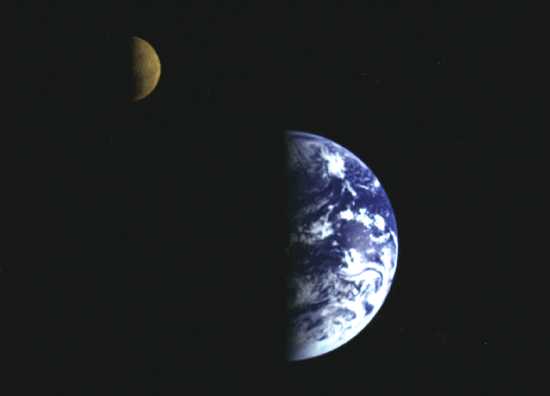
Due to friction caused by the tides and stray space particles, the Earth’s rotation is very gradually slowing down. Estimates indicate that every century, the Earth takes about one five-hundredth of a second longer to rotate once. Around the beginning of the Earth’s formation, a day lasted about 13 or 14 hours, instead of today’s 24. The Earth’s slowing rotation is the reason we add one leap second once every few years. However, the time when our 24-hour system is no longer valid is so far off in the future, not many people have speculated what we will do when that time comes. Some reports suggest that we could add one extra duration of time on the end of each day, perhaps, eventually giving us 25-hour days, or change the duration of hour-length to divide the longer days into 24 equal pieces.
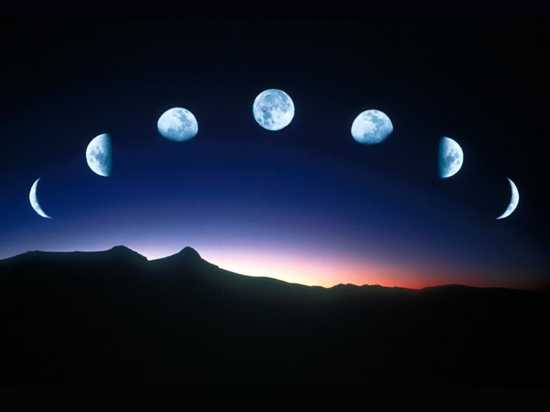
Every year, the Moon moves about 4 centimeters (1.6 inches) out from its orbit around the Earth. This is due to the tides the Moon brings to the Earth. The gravity of the Moon on the Earth distorts the Earth’s crust by a few centimeters. Since the Moon rotates much faster than the Moon orbits, the bulge pulls the Moon ahead and pulls it out of its orbit.
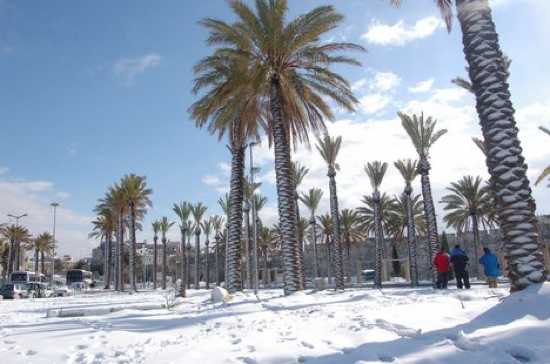
You may notice that the solstices and equinoxes mark the beginning of their respective seasons, rather than the middle. This is because the Earth takes time to warm up or cool down. Therefore, the seasons lag behind their respective daylight length. This effect is called seasonal lag and varies depending on the observer’s geographical location. The farther one travels to either pole, the smaller the lag tends to be. In many North American cities, the lag tends to be about a month, bringing the coldest weather around the 21st of January and the warmest weather around the 21st of July. For instance, at the end of August, you may still be taking advantage of the last of the summer weather, dressing lightly, making one last trip to the beach. However, the date, on the other side of the summer solstice which brings the same daylight length would be approximately the tenth of April. Most people wouldn’t even be anticipating summer then.








